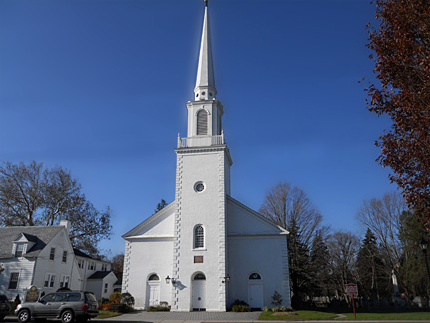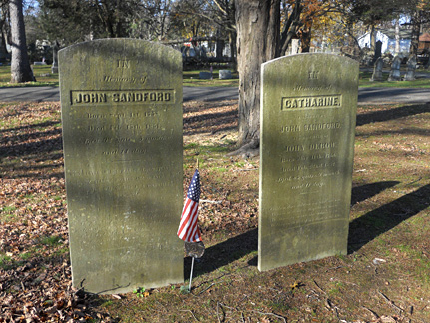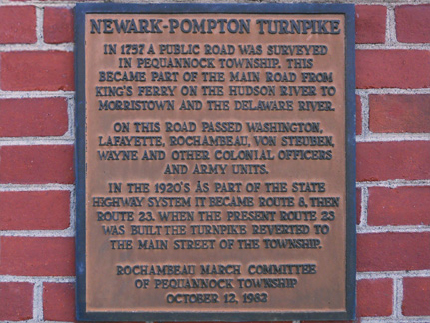

A boulder monument in front of the school commemorates the site of the Mandeville Farm, where General Rochambeau's troops camped en route to the Battle of Yorktown. The plaque on the boulder reads, "King Louis XVI's French Army under the command of General Count de Rochambeau camped here on the Mandeville Farm in August 1781. The troops were marching from Rhode Island to join General Washington and the Continental Army prior to the crucial Battle of Yorktown in Virginia." [1]
It is easy to miss this monument if you don't know it is here. It sits between two large hedges to the right of the entrance. (See the yellow arrow in the picture above).







The First Reformed Church was originally built in 1771. It was rebuilt in 1814, and then again in 1938 after a fire destroyed everything except the walls. [2] There are unconfirmed local traditions that George Washington may have attended the church for mass and/or a baptism. [3]
During the Revolutionary War, on the street across from the church, a Liberty Pole was erected to show support for the American cause. [4]
There are at least eight Revolutionary War soldiers buried in the cemetery: [5]
Captain Colfax
Died 1790
Thomas Doremus
April 25, 1750 - September 9, 1813
Abraham Mandeville
May 11th 1823; Age 72 Years, 6 months, 19 Days
John Sanford
September 1, 1758 - February 15, 1851
Served as a captain in Spencers Regt. in the Revolutionary War.
Also served in the War of 1812.
Philip P. Schuyler
1764-1846
Henry Wanmaker
Died October 31 1828, age 72
Henry Van Ness
Feb 18, 1754 - March 12, 1816
John DeBow (Headstone no longer exists) [6]
Jan 13, 1739 (OS) - Apr 25, 1817
DAR number A031210
Served as a captain in the Eastern Battalion of the Morris County Militia.
A signer of the May 1776 "Articles of Association of the Freeholders and Inhabitants of Pequannock, in the County of Morris"



A plaque on the front of the Municipal Building tells the history of what is now known as Newark-Pompton Turnpike, dating back to 1757. This includes its Revolutionary War significance: "On this road passed Washington, Lafayette, Rochambeau, Von Steuben, Wayne and other colonial officers and army units." [7]

Source Notes:
1. ^ Placed by the Hester Schuyler Colfax Chapter DAR in 1981 (1981 was the Bicentennial of the Battle of Yorktown)
2. ^ Dates and information concerning the building and rebuilding of the church obtained from the plaque above the church entrance, and the Morris County Heritage Commission sign in front. (Both pictured above)
3. ^ There are references to Washington's possible attendance at the church in several articles. Most of them state that his attendance is unconfirmed.
• On Appendix A, Page 2 of the document, Open Space and Recreation Plan Update - 2012, compiled by The Land Conservancy of New Jersey and the Pequannock Township Open Space Advisory Committee, it states, "While Washington stayed at the Schuyler-Colfax House in nearby Pompton, unproven oral history states that he attended church services in the First Reformed Church located in Pompton Plains, also known as the Pompton Meeting House, which had been constructed in 1771." This document is available online as a PDF here.
Similar similar statements can be found in other articles. These usually acknowledge that the reports are unconfirmed, so it would appear there is no primary documentation for it.
However, since the Schuyler-Colfax is only several miles away, this seems possible. The fact that Washington stayed at the house from July 11-14, 1777, and that the 13th was a Sunday, also adds to that possibility.
• Another possibility that has been mentioned is that Washington was here to attend a baptism. A July 26, 2009 Bergen Record article Community Rising to Old Heights by Andrea Alexander states, "It's a fact that George Washington was the godfather of a child whose parents were members of the church. But it's uncertain whether Washington ever set foot in the sanctuary." However, the article does not state what documentation shows that Washington was godfather to a child at the church.4. ^ Open Space and Recreation Plan Update - 2012, compiled by The Land Conservancy of New Jersey and the Pequannock Township Open Space Advisory Committee , Appendix A, Page 3 . Available online as a PDF here.
• David Hackett Fischer Liberty and Freedom: A Visual History of America's Founding Ideas( Oxford University Press: Rutgers University Press, 2005) p.47. Fischer lists Pequannock as one of the towns in New Jersey that erected Liberty Poles. This book is can be read at Google Books Here.5. ^ Names and date information taken from gravestones and markers in the cemetery.
Sanford's actual gravestone states that he fought in the Revolutionary War and the War of 1812. Another more modern marker in front of the grave provides the information about his rank and regiment.
The Colfax grave is marked with a Revolutionary War Soldier marker by the Garrett A. Hobart Chapter of the Daughters of the American Revolution. His first name is no longer readable on the stone.
Doremus, Mandeville, Schuyler, Wanmaker, and Van Ness have markers stating "U.S. Veteran", but do not actually state Revolutionary War. However, in each case the dates listed for their birth and death led me to conclude that they were most likely Revolutionary War veterans.6. ^ Record of Captain DeBow's burial in this cemetery in:
George Van Riper , Maryjane Proctor , Pompton Plains Reformed Church Cemetery (Paterson NJ: Passaic County Historical Society, 2002) p.9
This book is based partly on the work of Edwin A. Doremus, who beginning in 1931 transcribed by hand the inscriptions on the gravestones in the cemetery.
I was made aware of this information by Linda Peloquin, a descendant of Captain DeBow. According to Linda, "The grave no longer has a headstone but must have had one in 1931 when Edwin Doremus copied the individual inscriptions from headstones in the cemetery. I suspect that when the church burnt in October 1937 and then was rebuilt that this and other stones were either moved to preserve them and subsequently lost or may have been damaged or otherwise obliterated during the fighting of the fire. Either way, the stone was there in 1931 to be recorded by Doremus but isn't there now."
7. ^ Plaque placed by the Rochambeau March Committee of Pequannock Township, on October 12, 1982

The ultimate field guide to New Jersey's Revolutionary War historic sites!
Pequannock New Jersey Revolutionary War Sites • Pequannock New Jersey Historic Sites
Mandeville Farm Encampment Monument • First Reformed Church of Pompton Plains • Newark-Pompton Turnpike Marker
Website Researched, Written, Photographed and Designed by Al Frazza
This website, its text and photographs are © 2009 - 2024 AL Frazza. All rights reserved.